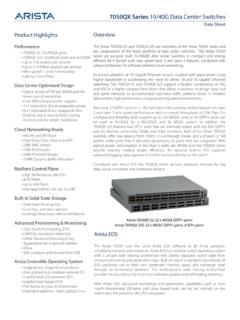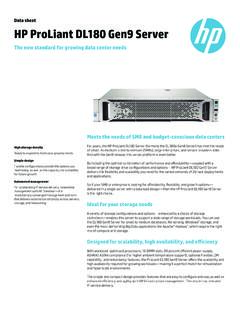Transcription of Recalibrating global data center energy-use estimates
1 SCIENCEPHOTO: GOOGLEBy Eric Masanet1,2, Arman Shehabi3, Nuoa Lei1, Sarah Smith3, Jonathan Koomey4 data centers represent the informa-tion backbone of an increasingly digitalized world. Demand for their services has been rising rapidly (1), and data -intensive technologies such as artificial intelligence, smart and connected energy systems, distributed manufacturing systems, and autonomous vehicles promise to increase demand fur-ther (2). Given that data centers are energy-intensive enterprises, estimated to account for around 1% of worldwide electricity use, these trends have clear implications for global energy demand and must be ana-lyzed rigorously.
2 Several oft-cited yet sim-plistic analyses claim that the energy used by the world s data centers has doubled over the past decade and that their energy use will triple or even quadruple within the next decade (3 5). Such estimates contrib-ute to a conventional wisdom (5, 6) that as demand for data center services rises rap-idly, so too must their global energy use. But such extrapolations based on recent service demand growth indicators overlook strong countervailing energy efficiency trends that have occurred in parallel (see the first fig-ure).
3 Here, we integrate new data from dif-ferent sources that have emerged recently and suggest more modest growth in global data center energy use (see the second fig-ure). This provides policy-makers and en-ergy analysts a recalibrated understanding of global data center energy use, its drivers, and near-term efficiency implications of growing de-mand for data centers requires robust understanding of the scale and drivers of global data center energy use that has eluded many policy-makers and energy analysts.
4 The reason for this blind spot is a historical lack of bottom-up information on data center types and locations, their in-formation technology (IT) equipment, and their energy efficiency trends. This has led to a sporadic and often contradictory litera-ture on global data center energy where data center energy use is heading requires considering service demand growth factors alongside myriad equipment, energy efficiency, and mar-ket structure factors (see the first figure). Bottom-up analyses tend to best reflect this broad range of factors, generating the most credible historical and near-term energy-use estimates (7).
5 Despite several recent na-tional studies (8), the latest fully replicable bottom-up estimates of global data center energy use appeared nearly a decade ago. These estimates suggested that the world-wide energy use of data centers had grown from 153 terawatt-hours (TWh) in 2005 to between 203 and 273 TWh by 2010, totaling to of global electricity use (9).Since 2010, however, the data center landscape has changed dramatically (see the first figure). By 2018, global data cen-ter workloads and compute instances had increased more than sixfold, whereas data center internet protocol (IP) traffic had in-creased by more than 10-fold (1).
6 data cen-ter storage capacity has also grown rapidly, increasing by an estimated factor of 25 over the same time period (1, 8 ). There has been a tendency among analysts to use such ser-vice demand trends to simply extrapolate earlier bottom-up energy values, leading to unreliable predictions of current and future global data center energy use (3 5). They might, for example, scale up previous bot-tom-up values ( , total data center energy use in 2010) on the basis of the growth rate of a service demand indicator ( , growth in global IP traffic from 2010 to 2020) to ar-rive at an estimate of future energy use ( , total data center energy use in 2020).
7 But since 2010, electricity use per compu-tation of a typical volume server the work-horse of the data center has dropped by a factor of four, largely owing to processor-efficiency improvements and reductions in idle power (10). At the same time, the watts per terabyte of installed storage has dropped by an estimated factor of nine ow-ing to storage-drive density and efficiency gains (8). Furthermore, growth in the num-ber of servers has slowed considerably ow-ing to a fivefold increase in the average number of compute instances hosted per server (owing to virtualization), alongside steady reductions in data center power us-age effectiveness (PUE, the total amount of energy used by a data center divided by the energy used by its IT equipment).
8 Both of these trends have been largely driven by shifts in compute instances to energy-efficient cloud and hyperscale data cen-ters, the largest data center type (1, 2). In the United States the world s largest data center market industry-vetted bottom-up analyses of these efficiency trends identi-fied a plateau in national data center en-ENERGYR ecalibrating global data center energy-use estimatesGrowth in energy use has slowed owing to efficiency gains that smart policies can help maintain in the near term1 McCormick School of Engineering and Applied Science, Northwestern University, Evanston, IL, USA.
9 2 Bren School of Environmental Science and Management, University of California, Santa Barbara, CA, USA. 3 Energy Technologies Area, Lawrence Berkeley National Laboratory, Berkeley, CA, USA. 4 Koomey Analytics, Burlingame, CA, USA. Email: FORUMAs demand for data centers rises, energy efficiency improvements to the IT devices and cooling systems they house can keep energy use in 28 FEBRUARY 2020 VOL 367 ISSUE 6481 Published by AAASon March 20, 2020 from SCIENCE : X. LIU/SCIENCE ergy use since 2010, despite rapid increases in demand for data center services (11).
10 We now expand that analysis to the global level and show that strong continued effi-ciency progress can maintain an energy use plateau for the next few years through pro-active policy initiatives and data center en-ergy-management practices. These new bot-tom-up estimates form the basis of recent global data center energy values utilized by the International Energy Agency (12).The data leveraged here facilitate a more technology-rich and temporally consistent approach than was available previously. Since 2011, analysts at Cisco have published data and outlooks for worldwide server stocks, data center workloads, server virtual-ization levels, and storage estimates for tradi-tional, cloud, and, most recently, hyperscale data centers (1).










